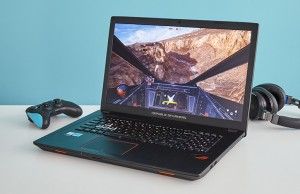Laptop Mag Verdict
The Asus ROG Strix GL753 offers gaming on a budget with a comfortable keyboard and vivid display, but it struggles with intensive titles at high settings.
Pros
- +
Comfortable, RGB-backlit keyboard
- +
Keeps cool while gaming
- +
Vivid display
- +
Above-average battery life
Cons
- -
Not a looker
- -
Finicky touchpad
- -
Struggles with intense games at high settings
- -
A little pricey
Why you can trust Laptop Mag
If you're looking for a gaming PC but don't have the cash to drop on something that's VR-ready, you can still find a laptop that will play most games. The Asus ROG Strix GL753 ($1,099 to start, $1,299 as tested) is one of the first notebooks on the market with Nvidia's GTX 1050 Ti GPU, along with the company's first RGB-backlit keyboard to add a bit of color. It's a solid laptop, but other systems are on the way with similar specs for under $1,000.
Design
Asus took the awesome design that it uses with its premium ROG machines and dumbed it down for its budget models. The result is a plastic beast that's more garish than sleek. The lid is made of black plastic with a faux-aluminum pattern, and while the premium machines have glowing lights on the sides of the logo, the company opted for orange neon paint on the lid of the Strix, making it look like a race car bed.
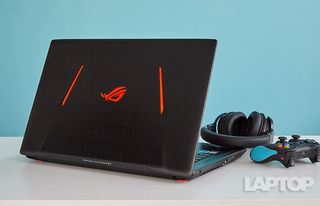
Lifting the lid reveals the 17.3-inch, 1080p display and an island-style keyboard complete with number pad. There's a bit of neon orange on the plastic chassis, too: the ROG logo in the bottom right-hand corner and a stripe around the touchpad. There are a few more orange accents on the front-facing speakers under the palm rest.
At 6.4 pounds and 16.3 x 10.7 x 1.3 inches, the Strix is light for a 17-inch gaming notebook. The Alienware 17 R3 is a noticeably heavier 8.3 pounds and 16.9 x 11.5 x 1.3 inches. Unsurprisingly, the 14-inch MSI GS63VR 6RF Stealth Pro is lighter at 4.2 pounds and smaller at 14.9 x 9.8 x 0.7 inches.
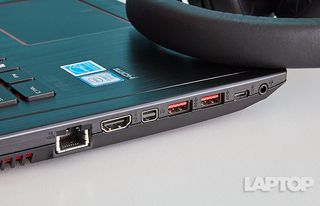
The sides are lined with ports to connect to external displays and attach peripherals. An Ethernet jack, HDMI and Mini Display Port outputs are on the left side, along with two USB 3.0 ports, a single USB 3.1 Type-C port and a headphone/microphone jack. The right side features a Blu-ray drive, another USB 3.0 port and a USB 2.0 port as well as a lock slot. An SD card reader is hidden just beneath the palm rest.
MORE: Best Asus Laptops
Display
The Strix boasts a 17.3-inch, matte 1080p display that shows off sharp, vivid details, but it isn't as bright as the competition's. I watched the latest trailer for Power Rangers and was able to make out every little cube that made up Bryan Cranston's character Zordon. Elizabeth Banks' Rita Repulsa costume was a deep, emerald green that popped against the street during a battle with the Rangers. Thanks to the screen's 178-degree viewing angles, I could see the trailer even from the far side of the laptop.
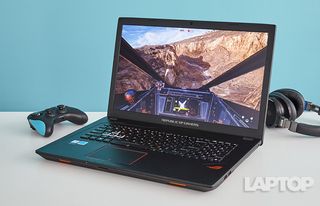
When I played Batman: Arkham Knight, the red-and-purple neon signage atop stores in Gotham City contrasted nicely against a cloudy night sky, and I could see the raindrops pelting the Dark Knight's cape. The viewing angles were still great, but it was hard to make out Batman in the dark when I wasn't looking straight at the screen. Even though the screen doesn't support Nvidia's G-Sync, I didn't have any problems with screen tearing.
The screen on the Strix reproduces an excellent 124 percent of the sRGB color gamut, though it falls just short of the desktop-replacement average (128 percent), and far below the Alienware 17's (174 percent), but it's better than the Stealth Pro (111 percent).
With its high Delta-E score of 2.2, the Strix's colors aren't very precise (0 is ideal). This mark is worse than the average (1.5), the Stealth Pro (2) and the Alienware (0.8).
Our light meter measured the Strix's average display brightness at 285 nits, which is just below the 295-nit average and dimmer than the Alienware (319 nits), but it was brighter than the Stealth Pro (242 nits). Despite the score, I found the screen to be bright enough for both casual use and gaming.
Audio
The speakers on the Strix GL753 are pretty powerful. When I listened to Tegan and Sara's "Closer," the sound immediately filled our small conference room with a blast of synths, vocals and drums. With the preloaded Dolby-powered ICEPower AudioWizard, I switched to the Action preset, which emphasized the percussion and cymbals, but I think the default multimedia setting is fine for most people when they're just watching YouTube videos.
When I played Batman: Arkham Knight, I found that the speakers really packed a punch when the Batmobile fired missiles at drones and enemies talked through walkie-talkies. The background music, however, was quiet. I tried switching to action mode, and it provided a more well-rounded soundscape.
MORE: The Best Gaming Laptops
Keyboard and Touchpad
The Strix's keyboard offers an extremely comfortable typing experience. Between its deep 2.1 millimeters of key travel and 60 grams of required actuation, I never came close to bottoming out. On the 10fastfingers.com typing test, I typed at a speedy 115 words per minute, exceeding my average of 107 wpm. My only complaint is that the keys could stand to pop up a bit faster, which would be better for quick-twitch reactions while gaming.
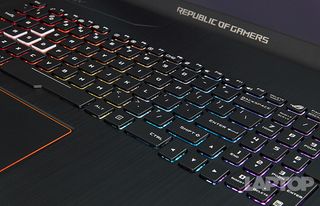
This is one of Asus' first laptops with an RGB-backlit keyboard. Out of the box, all of the keys were red, but with the new ROG Aura Core software, I was able to change or cycle between hues and separate the keyboard into four different zones to give them each their own colors. I would prefer a bit more customization, like the ability to customize every single key's color, but it's nice to finally see something other than red on a ROG. The software is limited to colors, however, so don't expect to start setting custom macros.
Get a gaming mouse, though, because the 4.1 x 2.8-inch touchpad is a bit finicky. While the cursor is accurate and I had no trouble performing gestures like swiping three fingers up to see all of my open programs, I had to be very specific about where I clicked. Particularly, I often had to use the very bottom of the trackpad to right click, as it didn't always accept that input in more comfortable locations.
Gaming, Graphics and VR
The Strix will play intense games, thanks to its Nvidia GeForce GTX 1050 Ti GPU with 4GB of VRAM, but that entry-level GPU can have a little trouble running intense titles at their highest settings.
When I played Batman: Arkham Knight at 1080p on high settings, the Strix ran the game between 40 and 55 frames per second as I used the Batmobile to trade missiles with unmanned tanks on the streets of Gotham City. I noticed that when I drove really fast, however, the frame rate dropped slightly. It was smoother when I switched all of the settings down to normal, and the game stayed between a more stable 47 to 60 fps.
While playing Batman: Arkham Knight, the speakers really packed a punch when the Batmobile fired missiles at drones.
The GPU struggled on our regular benchmarks. On Metro: Last Light (high settings, 1080p), the Strix reached just 28 fps, which is lower than our 30-fps playability threshold. The Stealth Pro (GTX 1060) and Alienware (GTX 980M) delivered a better 45 fps and 37 fps, respectively.
On Hitman (1080p, Ultra settings with DirectX 12), the Strix again hit 28 fps, falling far short of the 88-fps average and the Stealth Pro's 48 fps.
On the Rise of the Tomb Raider benchmark at medium settings, the Strix reached 28.9 fps, falling just short of the average.
Don't expect to connect an HTC Vive or Oculus Rift to the Strix, because it won't work. While The GTX 1050 and 1050 Ti are meant to provide better performance than Nvidia's previous generation of GPUs, neither is really considered to be VR-ready. The laptop earned a score of 2.4 on the Steam VR benchmark, rendering those immersive titles unplayable. The Stealth Pro hit 7.4 on the same test.
When you aren't gaming, the laptop falls back to integrated Intel HD Graphics 630.
Performance
Thanks to its 2.8-GHz Intel Core i7-7700HQ CPU (it's among the first gaming notebooks with a "Kaby Lake" processor), 16GB of RAM, 256GB SSD and a 1TB 5,400-rpm HDD, the Strix is primed to multitask. I switched between Grand Theft Auto V on very high settings and an instance of Chrome with 25 open tabs without experiencing any signs of lag.
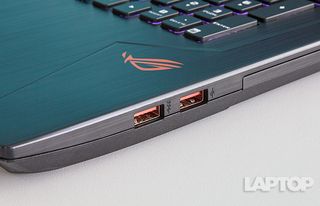
The Strix notched a score of 13,693 on the Geekbench 3 overall performance test, falling short of the desktop-replacement average (17,478) and the Alienware (Intel Core i7-6820HK, 13,906) but surpassing the Stealth Pro (Core i7-6700HQ, 13,454).
It took the Strix 23 seconds to copy 4.97GB of mixed-media files, which translates to a rate of 221.3 megabytes per second. That's significantly slower than the 560.8-MBps category average, the Stealth Pro (565.5 MBps) and the Alienware (509 MBps).
Asus' notebook paired 20,000 names and addresses in 3 minutes and 19 seconds on our OpenOffice spreadsheet macro. That's speedier than the average (3:34), as well as the Stealth Pro (3:38) and Alienware (3:53).
Battery Life
The ROG Strix will last longer on a charge than most desktop replacements. It endured for 5 hours and 25 minutes on the Laptop Mag Battery Test, which involves continuous web browsing over Wi-Fi. That's 1 hour longer than the average (4:23) and far better than the Stealth Pro (2:54). The Alienware, perhaps thanks to its last-gen graphics card, lasted the longest at 6:07.
MORE: Laptops with the Longest Battery Life
Webcam
If you're using this computer for streaming, get yourself an external webcam. When I used the 720p webcam for a selfie in our lab, the resulting photo was dark and blurry. My brown shirt appeared closer to black, my hair was blurry and the walls behind me looked grainy.
Heat
The Strix was nice and cool in our testing. After streaming 15 minutes of HD video from YouTube, the bottom of the laptop measured 88 degrees Fahrenheit, the keyboard reached 83 degrees and the touchpad hit 81 degrees -- all of which are below our 95-degree comfort threshold.
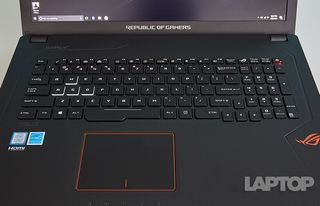
When I played Batman: Arkham Knight for 15 minutes, the center of the keyboard hit 91 degrees, the touchpad reached 88 degrees and the bottom of the notebook was 105 degrees.
Software and Warranty
Asus' pre loaded software is a mix of gaming-specific apps and a few other useful utilities. Most notable is the ROG Gaming Center, a complete dashboard that shows everything affecting performance, including CPU and GPU memory and temperature, as well as options to boost fan speeds and disable the Windows key. The other major gaming app, GameFirst IV, makes it easy to prioritize which apps use internet bandwidth for a lag-free experience.
Additionally, Asus' Splendid Utility lets you control color temperature (perfect for some late-night gaming), and XSplit Gamecaster is onboard for streaming.
Unfortunately, there's a bit of bloatware packed in too, including Netflix, Minecraft, Drawboard PDF, Candy Crush Soda Saga, Royal Revolt II and Twitter.
Asus sells the ROG Strix GL753 with a one-year warranty. See how the company did on our Tech Support Showdown and Best and Worst Brands rating.
Configurations
The Asus ROG Strix GL753 we reviewed is a $1,299 model that packs a 2.8-GHz Intel Core i7-770HQ CPU, 16GB of RAM, Nvidia GeForce GTX 1050 Ti GPU with 4GB of VRAM, a 256GB M.2 SSD and a 1TB, 5,400-rpm hard drive.
For $1,099, you can get a version with an Nvidia GTX 1050 GPU instead of the 1050 Ti. That version also ditches the SSD together, leaving you with only the hard-disk drive.
Bottom Line
The Asus ROG Strix GL753 is an affordable gaming laptop with a comfortable, RGB-backlit keyboard, vivid display and Nvidia GTX 1050 Ti GPU.
When a laptop comes along with a 1050 or 1050 Ti with a subthousand-dollar price range, that will almost assuredly become a better deal (and we know they're coming. We saw the Dell Inspiron 15 7000 Gaming and Acer Aspire VX 15 at CES). Otherwise, I'm hard-pressed to recommend anything with a GPU that isn't Pascal-based.
The one exception is if you immediately need a laptop with more configuration options. You can still buy a version of the Alienware 17 R3 on Amazon (though Dell is phasing it out for newer models), some of which offer 4K displays. It's great for watching movies, but you sure won't be gaming at that resolution with a 980M GPU.
Your best bet right now is to accept the Strix for what it is: a solid budget gaming laptop with a nice keyboard and finicky touchpad, that's available immediately. But keep in mind that laptops with this GPU will be very competitive in pricing sooner rather than later.
Asus ROG Strix GL753VE Specs
| Bluetooth | Bluetooth 4.0 |
| Brand | ASUS |
| CPU | 2.8-GHz Intel Core i7-7700HQ CPU |
| Card Slots | SD memory reader |
| Company Website | asus.com |
| Display Size | 17.3 |
| Graphics Card | Nvidia GeForce GTX 1050 Ti (4GB) |
| Hard Drive Size | 1 TB |
| Hard Drive Speed | 5,400rpm |
| Hard Drive Type | Serial ATA |
| Highest Available Resolution | 1920 x 1080 |
| Native Resolution | 1920x1080 |
| Operating System | Windows 10 |
| Optical Drive | BD-ROM/DVD |
| Optical Drive Speed | 8X |
| Ports (excluding USB) | HDMI, Lock Slot, Mini DisplayPort, USB 3.1 with Type-C, USB 2.0, USB 3.0, Combo Headphone/Mic Jack, Ethernet |
| RAM | 16GB |
| RAM Upgradable to | 32GB |
| Secondary Hard Drive Size | 256GB |
| Secondary Hard Drive Type | M.2 SSD |
| Size | 16.3 x 10.7 x 1.3 inches |
| Touchpad Size | 4.1 x 2.8-inches |
| USB Ports | 6 |
| Video Memory | 4GB |
| Warranty/Support | 1 year |
| Weight | 6.4 pounds |
| Wi-Fi | 802.11ac |
| Wi-Fi Model | Intel 2x2 802.11ac |
